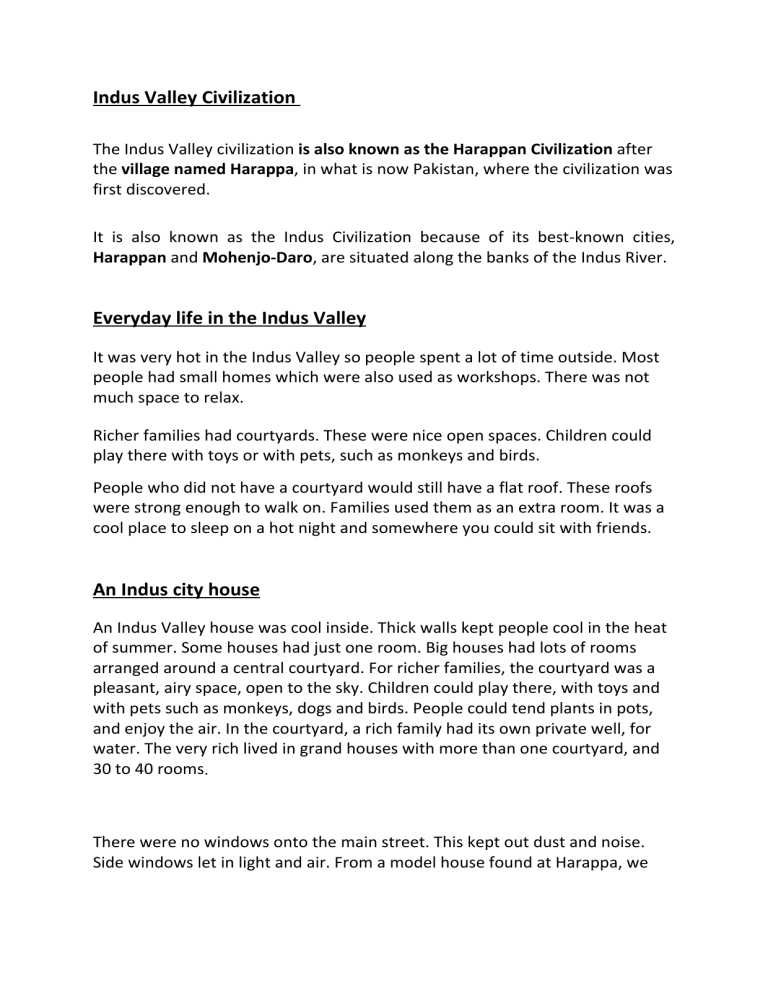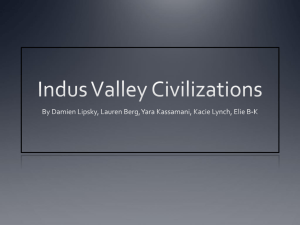
Indus Valley Civilization The Indus Valley civilization is also known as the Harappan Civilization after the village named Harappa, in what is now Pakistan, where the civilization was first discovered. It is also known as the Indus Civilization because of its best-known cities, Harappan and Mohenjo-Daro, are situated along the banks of the Indus River. Everyday life in the Indus Valley It was very hot in the Indus Valley so people spent a lot of time outside. Most people had small homes which were also used as workshops. There was not much space to relax. Richer families had courtyards. These were nice open spaces. Children could play there with toys or with pets, such as monkeys and birds. People who did not have a courtyard would still have a flat roof. These roofs were strong enough to walk on. Families used them as an extra room. It was a cool place to sleep on a hot night and somewhere you could sit with friends. An Indus city house An Indus Valley house was cool inside. Thick walls kept people cool in the heat of summer. Some houses had just one room. Big houses had lots of rooms arranged around a central courtyard. For richer families, the courtyard was a pleasant, airy space, open to the sky. Children could play there, with toys and with pets such as monkeys, dogs and birds. People could tend plants in pots, and enjoy the air. In the courtyard, a rich family had its own private well, for water. The very rich lived in grand houses with more than one courtyard, and 30 to 40 rooms. There were no windows onto the main street. This kept out dust and noise. Side windows let in light and air. From a model house found at Harappa, we can see that windows may have had wooden shutters with grilles (barred openings) to let in air and light. All that are left today are the ground floors of houses that once had two or three floors. Stairs led to the upper floors and roof. Walls were covered with mud plaster. It is not clear if people painted the walls. Sanitation and Sewerage System In the bathroom, people stood on a brick 'shower tray' and tipped water over themselves from a jar. The clean water came from a well. Dirty water drained through a pipe out through the wall into the drain in the street. Toilets had brick seats. The toilet was flushed with water from jars. The waste flowed out through clay pipes into a drain in the street. Waste was carried away along the drains to 'soak pits' (cesspits), Cleaners dug out the pit and took the waste away. They also took away rubbish from bins on the side of houses. Rich and poor Most people were poor and had to work hard like farming, fishing or making things. The richest people in an Indus city were probably people who owned a lot of land, or traders who controlled the buying and selling of luxury goods, such as rugs, jewels, minerals and metals. Poor traders went to market to sell fish, fruit (such as melons) or a few clay pots. Rich traders loaded their goods on ships sailing off across the sea. They wore fine clothes, and lived in big houses with servants and perhaps slaves. Indus people did not use money. It's likely that wealth was measured by how much land a person had - or how many cattle, or how many sacks of grain. Art and Architecture The Indus Valley civilization left no temples or tombs like the Pyramids of Egypt, and no great statues of kings or gods. Indus Valley people made small figures of people and animals using metal and clay. Only a few small statues survive. One is the Priest-King, with his beard, and his patterned robe. The most famous piece of Indus Valley art is ‘The little dancing girl’ made of bronze metal. Indus Valley Writing Archaeologists still haven’t unraveled this mystery of what language was spoken during this civilization. Archaeologists haven’t gathered enough proof. They were nearly 400 characters in Indus script. The longest word had 26 characters. Writing was done using a pointed stick in soft clay, or with a sharp tool to scratch marks on stone or metal. It is likely that only a few people could read and write, like scribes. But perhaps traders could read enough to tell what was written on seals. Most Indus Valley writing was probably to do with trade, government or religion. People wrote the first line from right to left, the second line from left to right, and so on. The Ancient World and Us Each ancient civilization left a legacy to future generations. People pass on knowledge, and retell old stories. They copy and improve technology. Sometimes they imitate ancient art or architecture or clothing. The Indus Valley people did not leave great structures, like the Pyramids of Egypt or the Great Wall of China. Their cities have almost vanished. Today, visitors see ruins dug into by archaeologists. Yet long after the Indus civilization, skills such as trading, farming and brick-making were passed on. Indus people helped shape the later cultures of India and Pakistan. The Indus people's gift to the world was showing us how to live in peace in cities. Their way of life was based on trade, without money. With few if any enemies, they did not need large armies. Not everyone was rich, but even the poor probably got enough to eat. In their clean, well-run cities the Indus people enjoyed beautiful as well as useful things. Life was not all work. They made toys and jewellery, as well as drains.


![Indus[1] - ridgeaphistory](http://s3.studylib.net/store/data/006736077_1-c59280ecd30594bac8ab21ec7bce4db4-300x300.png)


